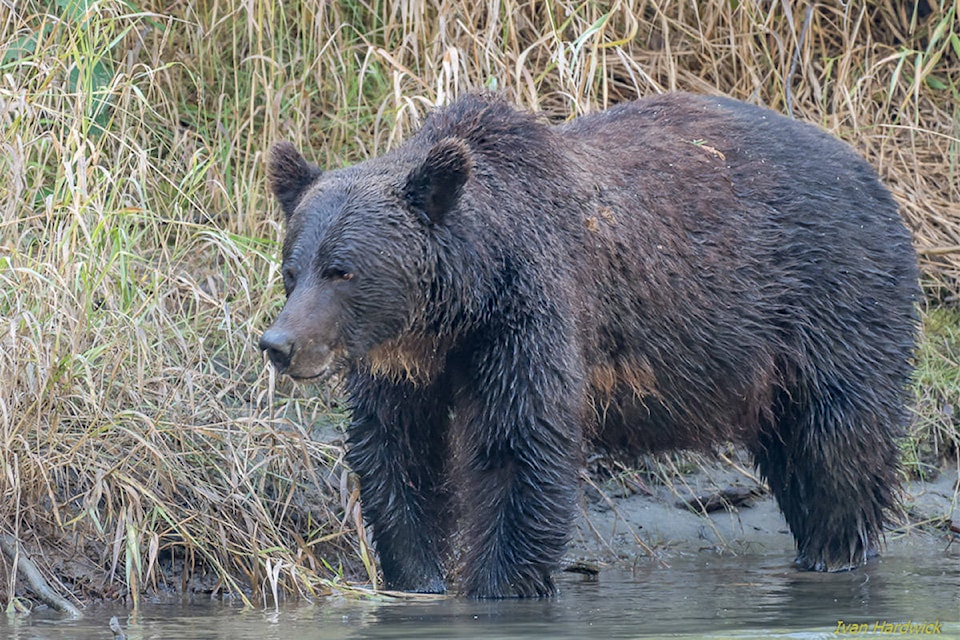Grizzly bear sightings are up in the Likely area this fall, said Sgt. Jeff Tyre of the Conservation Officer Service overseeing the Williams Lake, Quesnel and Bella Coola region.
“I’ve talked to a couple of people that have lived out at Likely upwards of 40 years and they said they have never seen the number of grizzly bears they are dealing with right now,” Tyre told Black Press Media.
Conservation officers relocated a set of grizzly bear twins a short distance away from Likely about a month ago and the number of conflicts went down, but there are still three to six grizzly bears in the area, Tyre said.
Tate Patton, Likely resident and chair of Cedar Point Provincial Park, said the three-year-old grizzly siblings were making their way up and down between Cedar Point and the Likely Bridge.
“Apparently they have a fondness for carrots and cilantro and tore up lots gardens,” he said.
Tyre said there are a couple of black bears in the area as well, but generally when there is a high concentration of grizzlies the black bears tend to move on.
“There have been some cases of grizzly bear depredation on black bears and grizzly bears this year as well so we do know that occurs.”
Patton said the grizzlies making their rounds are a mom and cubs and he’s heard rumours of a big boar as well.
“One has been sighted at our Goat Island Park. There is no sockeye this year so they are trying to get all the Chinook carcasses they can and I imagine they will be protective trying to food before hibernation,” he said as he urged anglers to be aware at all times if they are fishing in the Likely area. Be bear aware. Just because the area is landscaped doesn’t mean bears are not there.”
Patton said he is no bear expert, but has lived in the community for 24 years and noticed a difference this year.
Read more: QUIZ: The bare facts about bears
Bear complaint calls are also up ‘significantly’ in both Quesnel and Williams Lake compared to last year.
Tyre said the COS has been doing more enforcement and issued more dangerous wildlife protection orders, warnings and violation tickets for attractants in the region than they have ever done before.
“We’ve seen some improvements for sure, but there is still lots of room for more improvement. We are still getting lots of those calls about bears in apple trees.”
Tyre added a simple solution is to pick the apples, but also noted electric fencing can be a good deterrent.
If officers attend a call the complainant can expect to receive a ticket or a warning if merited.
“If it’s a really bad situation and the person is not making any advancements with attractant management then we will issue a dangerous wildlife protection order to deal with that attractant one way or another,” Tyre said.
Another big issue is household garbage being left outside of a residence and being accessible to bears on porches or perimeters of homes.
There are bears that have become dumpster dive experts, he added.
“In our area we are pressuring owners and managers of mobile home parks, where we are identifying problems with bears accessing garbage from dumpsters, to get bear-resistant bins and create a bin site that is protected from bears that only humans can access,” Tyre said.
It’s also imperative that people ensure bear-resistant bins are kept in a manner so that bears cannot access them, he added.
“We are working toward a solution.”
Tyre said they continue to co-ordinate with the local WildSafeBC co-ordinator as well.
Read more: WildSafeBC hires new co-ordinator for Cariboo region
With hunting season open for LEH moose and mule deer bucks, there has been a spike in incidents of deer being shot on private land.
“That is a large component of what we are dealing with right now. Sometimes it is an honest mistake and there are things we can do to improve that such as posting signage but the onus really does fall on the hunter to know where they are harvesting.”
Tyre said there are some great apps on the phone such as iHunter and Hunt Buddy BC that help identify private land and prevent those potential incidents.
A young cougar was removed from a residential area near Winger Road in Williams Lake that was going after livestock.
“It’s important we do all we can to remove attractants by putting pets in at night and protecting livestock in a fully-enclosed area at night that a cougar cannot access. They are primarily nocturnal.”
Electric fencing would also go a long way to reducing conflicts, he added.
There have been a few sightings of coyotes, including one in Boitanio Park in Williams Lake, that was stealing pizza.
“That could be linked to people feeding it and the coyote being able to access non-natural food sources,” Tyre said. “It’s quieted down now, which is a good thing, because it would have been a really difficult thing to deal with because of where it was located and the amount of people in the park.”
When people feed wildlife it makes the animals too comfortable, which just leads to conflict, or having to be destroyed, he added.
news@wltribune.com
Like us on Facebook and follow us on Twitter
